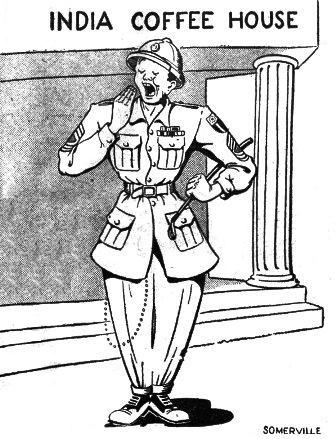|
In Unloading Ships
Roundup Staff Article
The India-Burma Theater unloaded ships faster than anywhere else in the world during the month of February.
As a result the percentage of idle port time for vessels during the month was less than that of any other Theater in the Army.
This Theater led its closest rival during that month in everything relating to vessel utilization by 100% or more.
Authority for these statements is Maj. Gen. W. E. R. Covell, Commanding General of Service of Supply for this Theater.
NO MYSTERY
The SOS chief says there is no mystery as to the cause of this productive record. He explains it as a natural result of efficiency, speed, determination and consistent effort on the part of Army personnel who work and manage the Indian coolies.
One G.I. explained it very simply:
We do our job in the best possible way. Our paths are not crossed by wild animals. We don't have to crawl on our bellies into foxholes with snakes. We don't have to live in disease infested jungles. But we do
|
WORK BEFORE DOCKING
One reason for the Calcutta efficiency is explained by a ship unloading operation that recently took place. The Transportation Corps soldiers boarded the vessel en route to the dock in a short canal emptying into the Hooghly River.
The men began to unloosen the cables which held the deck cargo consisting of a large number of Army trucks. In other words the men make a practice of starting their work even before the ship is tied up.
BEAT OWN SCHEDULE
On this same ship when the Army men told the crew the time in which they proposed to have the cargo ashore, they were met with incredulous smiles. But when the last pound had been sent ashore, they were ahead of their own schedule and the total time spent in unloading the vessel was exactly 73 hours and 29 minutes.
The worldwide figures for the month of March for comparison of I-B with other Theaters, are not available as yet. But Calcutta figures were higher than ever last month. During March Base Section 2 set nine records for handling supplies.
Foremost was a cargo discharge record of 30% more long tons of supplies over the previous peak month.
The record for daily discharge was broken four times by members of the port battalions.
Tonnage leaving Calcutta over the Assam line of communications reached a new high, with 19% more supplies moved than the previous record. This marked the third straight month that the line of communication tonnage figure had been broken. The daily tonnage was also broken three times during the month, and water shipments also set a top daily figure.
Output of reconditioned engines for trucks and other vehicles the Theater was the highest ever, while ordnance vehicles assembled and delivered showed the greatest increase over previous marks, with more than four times the number of vehicles assembled than ever before.
East Bengal rail and river tonnage for March increased 20% for a new all-time high. Shipments from the port direct to the consignee increased three percent to a high of 21%, eliminating duplicate handling by the depot of these supplies.
Covell has commended Brig. Gen. Bob Neyland, head of Base Section 2, and his men for their superb job of supply.
Chennault's 14th Hits Shanghai
HQ., 14TH AIR FORCE, CHINA - Daring pilots of Maj. Gen. Claire Chennault's 14th Air Force this week braved heavy losses to sweep enemy-held airfields throughout occupied China, attacking 10 different airdromes to further cripple the Jap air units which have offered declining resistance of late.
Surprise attacks on the Shanghai field destroyed 32 enemy planes, with 16 more probables and one damaged in a two-day period. Totals for the week, which included attacks from Hainan Island to Laohokow, were 46 destroyed, 19 probable and 13 damaged. The 14th lost 27 airplanes.
Bombers and fighters raked large Jap troop concentrations in the Han River area northwest of Hankow, causing heavy casualties, and also destroyed more than 150 vehicles. Chinese Air Force P-40's and CACW planes joined in these attacks. Bombers bore down on rail lines, locomotives and bridges north of the Yellow River.
Missions of P-38's strafed Jap soldiers driving north from the Black River Valley in Indo-China against French troops battling south of Hanoi. P-51's furnished air support by hitting Jap positions at Phu Lang Thuong and Lang Son.
|
Today this base unit, only one in ATC devoted exclusively to search and rescue of downed airmen, is a highly-organized, completely equipped, fully staffed organization, whose performance record is so outstanding that air crews bailing out over The Hump have a better than three-to-one chance of returning to their base alive.
But it was not always thus. A few months after its activation late in 1942, the India-China Division of the Air Transport Command was faced with the problem of rescuing pilots, crew members and passengers forced to parachute into the rugged mountain country its routes traverse.
Early in 1943, the first efforts to rescue parachuted airmen were made. Of Necessity - owing to the scarcity of aircraft for search duties and the operational difficulties existing at that time - search missions followed no organized pattern and were chiefly impromptu jobs. When an airplane crashed, or became disabled in flight and was abandoned, or, unreported and overdue, was classified as "missing," the first available crew and aircraft which could be spared from the Hump operation began a search for it.
BAD FACILITIES
Such crews did the best they could with what facilities they had, but delayed reports, meager information, and unfavorable weather often resulted in discouraging results. From such a beginning, however, the present Search & Rescue organization rapidly grew.
The purpose of rescue activities in ICD is to bring aid to all survivors of United Nations aircraft which have crashed along air routes operated by the Command. Particular missions are: (1) to search for missing aircraft and personnel in the Hump area; (2) to supply and rescue all personnel surviving from aircraft forced down or abandoned in the Hump area; (3) to identify crashed aircraft and salvage or destroy equipment aboard, and to identify, collect personal belongings from, and to arrange for burial of all bodies contained therein; (4) to augment gathering and dissemination of military intelligence pertaining to jungle survival and search and rescue work, and (5) to coordinate search-rescue activities with all allied units.
As ICD's Search and Rescue Squadron has grown into a highly specialized organization. Its success has grown with it. In 1943, 62% of personnel missing from flights over the Hump were rescued, and during the first six months of 1944, 77% were rescued. This was the result of improved technique in searching for, signaling and supplying bailed-out airmen, and the utilization of greater facilities - aircraft, communication, supply, and liaison - for finding "lost" crews. The saving of life has been increased greatly by the parachuting of medical officers and/or medical supplies, including plasma, and whole blood, to injured personnel located far from any other medical aid.
HUMP RUN
The operational difficulties of the Hump are well known. For a long time, and understandably, there was a fearsomeness in the word "Hump" itself. One of the chief factors was the almost complete lack of information in regard to the jungles, mountain gorges, and snow-capped ranges along the lines of flight. Another was the wild tribes inhabiting the region, thought of variously fanatical headhunters, murderous bandits, or inhospitable misanthropes. Still a third was the presence of roving Jap patrols along parts of the route, obviously eager to intercept parachuted airmen, and a fourth was enemy fighter planes, which, in the early days shot down an occasional unarmed, heavily loaded transport.
All this added up to one question every pilot asked himself when he started out over the Hump: "What are my chances of getting back if I have to bail out?" The Search & Rescue Squadron has emphatically provided the answer. As information has improved and the Jap interception menace has abated, the most insistent problem faced by the unit remains the ever-perilous, next-to-impenetrable jungle. There are many hundreds of square miles in which two parachutists who land more than 150 feet apart cannot hear each other's voices no matter how loudly they shout, and the records of jungle walkouts include dozens of instances of such men shouting to each other within this radius and endeavoring to join each other, then losing the sound of each other's voices entirely and proceeding to hack their way through the jungle alone for days or even weeks. Such is the heartbreaking terrain constantly fought by Hump bailouts and their rescuers.
MASS JUMP
One of the most important factors in the formation of an organization to conduct systematic search and rescue work was the celebrated "mass jump" of August, 1943, in which Eric Sevareid, of the Columbia Broadcasting System, State Department representatives, and other passenger participated. The survival of 20 of the 21 aboard the ill-fated plane amazingly climaxed a month of feverish anxiety. "Dozens of officers and men," Sevareid reported on reaching Calcutta, "put into motion an improvised system for getting supplies and information to us and for organizing the rescue party which saved the lives of every one of us." (One man aboard had died when his chute fouled in the tail assembly).
In October, 1943, Capt. John L. Porter was named "Flying Safety and Rescue Officer." The technique improvised in the Sevareid incident was improved upon. Men well adapted for rescue work were brought from other ICD stations to Chabua. The first aircraft assigned the squadron were two C-47's carrying for protection two .30 caliber guns each. One was fired by the co-pilot who held the gun in his lap and shot from the pilot compartment window; the other was manned by others of the plane's crew, who fired from the cargo door.
In early November, a Squadron crew in a C-47 spotted a Zero which had apparently crash-landed in a clearing, its pilot sitting on a wing. Diving the lumbering transport at the clearing, the crew left the enemy fighter bullet-riddled and the pilot dead beside it. A tiny Japanese flag was painted on the nose of the C-47 to call attention to its "combat" record.
|
RESCUE GROUP
Today, the Search and Rescue group continues to operate C-47's for air-dropping of supplies to grounded airmen, and as ships from which medical officers or other personnel can best jump to injured persons on the ground. In addition, fast B-25's, well-armed to ward off possible interception, make long-distance patrols to spot downed aircraft.
Tiny L-5's and L-4's are used for low-level, short-range search. They come in for other uses, too, for many times members of crews which have bailed out have been able to construct short crude air-strips on which the small craft could land and bring them out one by one. In one case, a paralysis victim, Lt. Robert Wesselhoeft, was brought out of the mountainous region of the China-Tibetan border in an L-5 with an improvised "bamboo lung" sustaining his life. Later, he was flown over the Hump, and finally to the United States on an ATC hospital ship, where he presently is recovering.
Search and Rescue activity always has been under the jurisdiction of the ICD intelligence division, with S & R headquarters in the Chabua area. Pioneered by Maj. Robert L. Wright, the Division Intelligence and Security Officer, much of its growth has come through the constant and increasing efforts of Maj. Roland L. Hedrick, Search and Rescue Intelligence Officer, who almost since the first has centered his attention on the countless details involved.
COLLECT DATA
Over the period of time since the informal beginning files of information on terrain, climate and peoples of the Hump have been accumulated by intelligence and other forces. Greatest single source of information has been observation by pilots making regular runs over the Hump.
Wreckage, smoke, evidence of attempts to signal, lights seen after nightfall - all are reported in "crew sightings," which are made by the individual pilot and turned in to his station intelligence officer, who forwards them to Division Intelligence for coordination. In cases where a pilot has sighted something of unmistakable urgency, he may be brought to Chabua and flown out in a Search & Rescue flight, acting as guide in locating the spot of the sighting. This information is augmented by reports from U.S. Aircraft Warning Stations, Chinese Net Stations, and combat supply and service units of Allied forces scattered over the area.
Maj. William H. Spruell - then a captain - was in charge of medical aspects of the early activities. Following the lead of his chief, Col. Don Flickinger, Division Surgeon, who had parachuted to the aid of the Sevareid party, Spruell made several jumps to attend injured personnel in the jungle. Since that time many other officers and enlisted men have bailed out in Search & Rescue missions.
PORTER KILLED
In December, 1943, Porter, who had figured in many hair-raising episodes, was killed when attacked by a dozen Jap fighters in the Fort Hertz region. He has been succeeded by several officers under whose leadership the squadron has maintained its high degree of success.
Present commander is Maj. Donald C. Pricer, veteran Hump pilot, operations officer and executive. Under Pricer's command is an entire organization of selected, trained personnel, practically all of them volunteers with specialized backgrounds to aid them in the hazardous search and rescue, air and ground activities.
Search & Rescue's cardinal principle is to notify downed personnel as quickly as possible that help is on the way, for this knowledge is a dominant factor in their struggle with the jungle. Even when no further aid is needed, a plane will often appear at a place where survivors are known to be, to remind them that they are not forgotten on the long trek out.
|
NEVER GIVE UP
No lost plane is ever given up, nor are records concerning a located crash ever closed until every man aboard has been accounted for. On a large board in the squadron Intelligence office at the base unit the location of every Hump downed plane is kept as up-to-the-minute as Intelligence can keep it. Beside the board is a relief map of the Hump area dotted with flags indicating pin-pointed locations of crashed planes - one color for reported, and other colors for each aircraft type identified by air reconnaissance.
There are three major phases of Search & Rescue work: the locating of crashed plane and personnel, the direction of personnel to the nearest ground party, and finally the evacuation. Missions involve a search pattern in an "area of maximum probability," defined as the area in which the presence of the lost aircraft is believed most probable. This area is determined by the lost plane's estimated time of arrival, its last radio reports, and reports from inhabitants along its route. Search patterns vary widely because of variations in the terrain.
Each night, after intelligence officers have interrogated rescue pilots, co-pilots and photographers, and the accumulated data is digested, the various crews are assigned to certain aircraft and certain missions for next day. Intelligence officers then brief them on the various missions assigned, and aid in co-ordinating communication that may have to be made between air and ground. The Rescue Intelligence Officer also organizes, briefs and dispatches ground parties, and pays search and rescue expenses.
REPORT RESULTS
Results of missions are reported in a daily search and rescue record, an incident summary report, and finally (when the job is finished) in a complete narrative of the total operation, including a survivors' interrogation report. A weekly bulletin on crashes, locations, facilities, progress of searches, and other pertinent information is distributed to all agencies concerned.
Liaison with British and other residents in the Hump area is an important factor of rescue work. Through the District Political Commissioners, missionaries and other British and American residents, much has been learned about the various native tribes. Some have proved fierce enough to warrant the early apprehensions, but by far the majority have been found friendly, co-operative and genuinely helpful. They have sometimes unnerved a downed airman by menacingly gesturing when his already abused stomach balked at such ceremonial delicacies as fish eyes, or the blood of a freshly decapitated calf, or the intestines of a mountain goat, but on the other hand they have saved many a grateful American who would almost surely have perished without their care.
When a Hump plane goes down, and the crew abandon it, high drama enters their lives along with extremes of hardship. They may spend 93 days away from their base, as one crew did (this is the longest recorded walkout) and they may encounter anything from cobras to tigers - leeches and lice being taken for granted. Or, as the famed "Shangri-La" crew did, they might be swept far off course and fall into the splendor and the lavish hospitality of the Tibetans' holy city of Lhasa, and, after being fed, entertained and lionized there, be solicitously guided from that remote fastness back to their own civilization in a thirty days' horseback journey.
Today, the men who fly the rescue mission, the medicos, cartographers, photographers, ground crew members, and ground rescue specialists all stand ready in Assam to rescue any airman of the Allied nations whose bad luck puts him out of his plane and on the ground. Stepped-up operations of all air force units in India, Burma and China have brought increased demands for search and rescue activity, and the organization of the full-scale AAF Base Unit with its own aircraft, warehouses and highly-trained personnel has met the need.
Gunner's Action Saves 11 Lives in Super-Fort
XX BOMBER COMMAND SUPER-FORTRESS BASE, INDIA - Only 35 seconds remained between 11 lives and death.
For gallantry in action in saving his crewmates and a costly airplane, Staff Sergeant John L. Austin of Shreveport, La., left gunner on a B-29 Super-Fortress, has been awarded the Silver Star.
BOMBS JAMMED
Over the target at Hankow in Jap-occupied China, three big incendiary bombs jammed in the rear bomb bay of the plane on which Austin was flying. The bombardier tried desperately to dispose of the bombs on the emergency system without success.
So without oxygen at 20,000 feet and with Jap fighters making fierce attacks from directly below the airplane, Austin volunteered to crawl into the bomb bay.
SPINNERS STARTED
What he saw was horrifying - the strong wind coming through the bomb bay had started the spinners turning on the three armed bombs, which meant as Austin knew, that the bombs would detonate within 35 seconds and that 11 men and an airplane would blow out of the war under puzzling circumstances.
This particular type of incendiary bombs contains a number of smaller cluster which burst from the main case when an explosive fuse is set off. And once the spinner turns and the fuse burns the big bomb will detonate in 35 seconds, which, in terms of feet, means that the bomb will fall from 20,000 feet to approximately 4,000 feet before bursting and scattering the smaller clusters.
PASSES OUT
Austin quickly made a lunge for the bombs and clamped his hands lightly over the spinners. He then managed to shove a cocking lever in the bomb bay which released all three bombs simultaneously. And then, obviously from lack of oxygen, he passed out; then a fellow crewman dragged him from the bomb bay and administered first aid.
Austin's citation stated in part, "By displaying such exceptional gallantry and courage under such tremendously adverse conditions. S/Sgt. Austin saved the lives of the entire crew and an extremely valuable aircraft."
|
The guys around the 1333rd Base Unit in Assam are both amazed and amused at Pvt. Julien Bronson's "female companion," Lucille. Lucille is a talking bird - an Indian Hill Myna, found in the Himalaya regions. Speaking Brooklyn Urdu, Lucille chatters, "Hello, Joe . . . what's cooking? . . . pretty teek," plus a shameful knowledge of profanity.
Frankly admitting that some mess hall coffee "hasn't been up to high G.I. standards," Lt. Col. C. T. Nordstrom, chief of the QM Substinence Division in New Delhi, has announced that fresh coffee, roasted and ground from the bean shortly before serving, will soon be routine throughout the I-B Theater. New roasters and grinders are being installed in all Army mess halls and all coffee beans will be obtained from local Indian suppliers, said to be some of the world's best.
British Sgt. Aynsley J. Morris, chauffeur and messenger for Maj. Gen. Howard C. Davidson, 10th Air Force chief, has been awarded the Bronze Star Medal "for meritorious achievement in connection with operations against the enemy."
And T/7 Osmosis Fink reports he knows of two brothers who have been in the Army nearly three years - and have never run into each other in India !
|
DUD BOMB CAMPAIGN
BY 10TH DEMOLISHERS
HQ., 10TH AIR FORCE IN BURMA - Dud bombs and booby traps, a menace to advancing troops in every war theater, are particularly a problem for the aggressive headquarters staff of Maj. Gen. Howard C. Davidson, commanding general of the 10th Army Air Force.
During the major portion of the campaign in Burma, Davidson's headquarters have been in front of the most forward fighter bases, not a normal location for an air force headquarters. As a result, rapid advances of the Tenth's staff have placed it frequently in areas where dud ammunition disposal is still in progress as the headquarters personnel comes rolling in on trucks to set up operations.
Jap air attacks in Northern Burma recently have been highly infrequent, the few attempted coming to a very sorry finish. But after a recent move, the headquarters of the Tenth underwent earth-shaking blasting for a number of days that had the elements of an all-out Jap raid. Dust, debris and bomb fragments showered tents and bashas as a bomb disposal squad worked on ridding the area of dangerous unexploded missiles.
It's never a dull moment in dud detonating as the men who do the job can testify. Headquarters personnel who have participated in the work are Capt. Robert D. Wessling, son of the R. A. Wessling's, 5139 Elverano, Eagle Rock, Calif.; Lt. Lewis W. Pollard, 61 St. Marks Rd., Dorchester, Mass.; Warrant Officer Edwin Hoerner, 4875 28th St., North, St. Petersburg, Fla.; and Pfc. Byron Huddleston, R.R. 1, Hot Springs, Ark.
They have exploded thousands of Jap bombs, artillery and mortar shells, mines, smoke grenades and booby traps and an occasional Allied bomb or shell. That the duds can be harmful is indicated by the fact that more than a score of individuals have been killed or hurt in portions of Burma by unauthorized handling of dud ammunition.
CURIOS IN I-B REASONABLE SAYS PX HEAD
The vast majority of curios in all India-Burma Post Exchanges are retailing below cost, Lt. Col. E. W. Diller, Army Exchange Chief for the India-Burma Theater, announced this week, following a recent criticism in a letter to Yank magazine about exorbitant prices in a PX along the Stilwell Road.
"The complaint may be justified," Diller said, "but everything possible is being done to eliminate such grievances. As evidence of this, please note that most PX prices on curios have been reduced 20 to 60 percent, and during the past February, when most of the markdowns were made, we took a loss of $200,000 or well over 600,000 rupees, on curios which it was felt were priced too high. And we're now trying to reduce prices on the few remaining articles not included in the February reductions."
Diller also pointed out that PX prices are pretty uniform throughout the Theater. Men in Burma and Assam don't pay any more for curios and other articles at their Army stores than troops in other areas.
Diller made it clear that curios and curio prices have always been a terrific headache to him and his staff. But soldiers want to buy the stuff, he said, and PXs have to stock them. Americans naturally compare prices here with the cost of comparable articles at home, but it's often forgotten that most of the curios are hand-worked, while those at home are machine-made, mass production articles.
"But I'd be glad to eliminate curios entirely," the Exchange Chief concluded, "if the men wish to take their chances on the open market."
I-B Signal Corps Shots In 'Objective, Burma!'
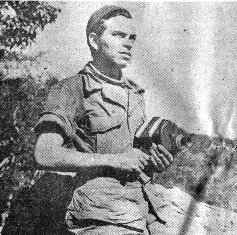 T/4 William Safran, whose pictures of the Myitkyina airborne operations were also used in Objective, Burma!,
is shown as he films a river crossing operation.
T/4 William Safran, whose pictures of the Myitkyina airborne operations were also used in Objective, Burma!,
is shown as he films a river crossing operation.
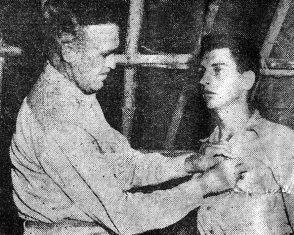 T/3 Daniel Novak is presented with the Bronze Star by Brig. Gen. Joe Cannon. Some of Noyak's shots of the Myitkyina
glider landings were used in Objective, Burma!
T/3 Daniel Novak is presented with the Bronze Star by Brig. Gen. Joe Cannon. Some of Noyak's shots of the Myitkyina
glider landings were used in Objective, Burma!
 S/Sgt. Victor F. Kayfetz poses along the Ledo Road, where cheesecake is calculated to impress safety on the drivers.
Kayfetz photographed food-dropping scenes from planes that were incorporated in Objective, Burma!
S/Sgt. Victor F. Kayfetz poses along the Ledo Road, where cheesecake is calculated to impress safety on the drivers.
Kayfetz photographed food-dropping scenes from planes that were incorporated in Objective, Burma!
|
MYITKYINA OPERATIONS PRESENTED
By T/SGT. ARTHUR HEENAN Roundup Staff Writer
India-Burma Signal Corps photographers were responsible for several scenes in the Warner Brothers picture, Objective, Burma!, dedicated to the exploits of Allied armies in the jungle-infested Orient.
Most of you have had, or will have, the opportunity to view the Errol Flynn film on the G.I. circuit. For the benefit of rear echelon commandos, the picture will soon appear on the commercial run, and we trust the Indian editing depredations will be less crude than usual.
SHOT BY G.I.'S
The picture is mostly studio stuff, but the scenes depicting Theater personalities, terrain, glider landings at Myitkyina, and food dropping were all shot over here by American G.I.'s of the Signal Corps.
The opening scenes show Lord Louis Mountbatten, the late Maj. Gen. Orde Wingate, Col. Phil Cochran, Gen. Joseph W. Stilwell, Lt. Gen. Dan I. Sultan and Maj. Gen. Frank Merrill. All the Theater brass were cameraed by India-Burma G.I.'s.
RAMGARH SEQUENCE
The Chinese troops at the Ramgarh Training Center, where "Uncle Joe" whipped his 38th and 22nd Chinese Divisions into shape for the Hukawng and Mogaung Valley campaigns are also shown in the beginning of the drama. These films came from the camera of Officer Candidate Nick Lyseczko, of New York City. Nick, now at Fort Benning, is an old Assam and Burma traveler for the Signal Corps and an ex-Roundup staffer.
The food dropping sequences as seen from the ground came from S/Sgt. David L. Quaid, Richmond Hill, N.Y.; T/3 Richard H. Spencer, North Hollywood, Calif.; S/Sgt. Edgar S. Bagley, Los Angeles, Calif. and Officer Candidate Emil S. Brodbeck, Mt. Vernon, N.Y.
MARAUDERS' FOOD DROPS PORTRAYED
PHOTOGRAPHER INJURED
The episode in which the food droppers were viewed inside the planes while in flight were taken by S/Sgt. Victor F. Kayfetz, New York City, and T/5 John G. Valence, Philadelphia, Pa. By an oddity Quaid was injured while taking one of these films, suffering a fractured leg, as he was hit by a free-falling mule feed bag before it hit the ground.
In the picture the scenes were all supposed to take place over Flynn's marooned parachuters. At the cost of reality we must inform you they were actually scenes of Merrill's Marauders being supplied in their North Burma campaign that culminated in the capture of Myitkyina.
ACTUAL LANDINGS
The glider landings in the latter section of Objective, Burma! were prints of the landing at Myitkyina. There is some unusually good action here. T/3 Daniel Novak of Minneapolis and T/4 William Safran of New York City were responsible for these. Safran received the Air Medal and Novak the Bronze Star for their parts in the Myitkyina airborne operations.
We saw the picture with photographer Kayfetz, who pointed out the parts that were the products of India-Burma men. Also with us were ex-Merrill Marauders, Pfc. Al Hall, Jersey City; Pfc. Herman Sims, Gatesville, Tex., and Pvt. Verner Nielsen of Denver.
THERE TOGETHER
At one food-dropping action, Kayfetz said, "That was over Nphum Ga, where we supplied the Marauders."
Hall turned around and said, "Hell, were you in one of those planes? Me and Sims here were down below."
It developed that Nielsen had also bumped into Kayfetz at Dinjan, when he was readying 75's for air dropping. Nielsen had been evacuated from the Marauders but was working on the supply end to his former buddies.
We were interested in the reactions of these men to the film. They had faced the hell of Burma first hand. All of them gave praise to the realism of the picture.
There is one scene which depicts the Flynn parachute troops wiping out the Jap garrison at a radar station. It had previously been explained that the Air Corps could not locate the target for accurate bombing due to camouflage.
"There wasn't any camouflage there at all," said Hall. "That was the first thing I looked for."
"Yes, and the way they wiped out those Japs just doesn't happen," stated Sims. "They should have had a couple of stragglers. There are always some wounded in an action like that."
The ex-Marauders were especially complimentary to Hollywood for what they called "faithful reproduction of jungle sounds."
JUNGLE SOUNDS
"Those animals and birds used to tip us off to the Jap monkeys," explained Hall. "Whenever anyone was moving through a bush the animals and birds would start calling. I suppose they similarly gave us away to the Japs. But when I saw one of those guys slapping the mosquitoes away, I said to myself, "Hell, I can remember that. It's Burma all right."
Nielsen said they should have incorporated the sounds of what he called the "wait now" bird, "All the time that damn bird would be calling," said Nielsen. "I can still hear it in my sleep at times. Always it was 'wait now, wait now.' He never changed his call."
FAMILIAR SCENE
There is a scene where the Flynn soldiers run out of supplies. That situation was also familiar to Sims and Hall. They were on a 21-day march to Shadazup, three days of which they were without food or water.
"We stuck a rifle grenade into a truckload of Japs outside Shadazup," recalled Hall. "That was when we got our first food in three days. It was covered with blood, but it tasted all right to us."
Sims also remembered how outside of Shadazup the Marauders had a machine gun planted near the road. Up the highway came a column of Japs marching at attention in parade formation, with an officer at their head.
THEY LAUGH
"That machine-gunner murmured, 'A dream, a dream,'" said Sims. "Then he let them have it. He must have got 50 Japs."
Every time a Jap was killed in the picture the ex-Marauders would laugh.
"I don't suppose it was really funny to anyone," remarked Hall. "But just seeing those guys go down makes you feel good. Wish it was as easy to knock them off in real life as it is in the movies."
However, take it from the men who have been through the Burma campaign. Objective, Burma! is an excellent example of realistic Hollywood craftsmanship.
10th Air Force Awards 40 Decorations To Air Evacs
HQ., EASTERN AIR COMMAND - More than 40 decorations were awarded recently to the flight surgeons, flight nurses, and medical technicians of a Medical Air Evacuation Squadron of the 10th Air Force, EAC, for meritorious achievement in bringing sick and wounded Allied troops out of Burma.
Air Medals and Oak Leaf Clusters to the Air Medal were earned by personnel of the unit, who had flown in C-47 hospital plane "operational flights totaling more than 100 hours over Burma, during which enemy attack was probable and expected."
The Air Medals awarded the flight nurses were the first to go to women in the 10th Air Force. The awards were pinned on by Maj. Gen. Howard C. Davidson, Commanding General of the 10th.
Flight nurses who received the medal were: Capt. Frances M. Barrett, Camino, Calif., Chief Nurse of the Squadron; Lt. Ellen J. Richards, Gary, Ind.; Lt. Katherine S. Hack, Phoenix, Ariz.; Lt. Mavis L. Kolb, Nacogdoches, Tex.
Others included: Lt. Laura M. Ginn, Brownsville, Tex.; Lt. Jean B. Yunker, Junction City, Ore.; Lt. Ruth G. Crocker, McCook, Neb.; Lt. Alice M. Burger, Milwaukee; Lt. Frances E. Dunn, Goshen, N.Y.; Lt. Clara J. Dillon, Des Moines, Iowa; Lt. Jane R. Naynes, Topeka, Kan.; Lt. Roberta S. Ross, Wilmette, Ill.; Lt. Laura L. Revel, Whittier, Calif. and Lt. Rachel A. Urschalitz, Findlay, O.
 "Where in the hell is that Good Conduct ribbon I was supposed to get?"
"Where in the hell is that Good Conduct ribbon I was supposed to get?"
|
Burma Violinist Plays Concerts
On Ball Diamond
HQ., 10TH AIR FORCE, BURMA - Pfc. Joseph Anthony Basile of Brooklyn has found himself a career on the baseball diamond. But it is balancing scales and not a bat that has made him a public figure with 10th Air Force wallahs. When Basile got the bugle call from his draft board he was studying music at Columbia University, and doubling as a concert violinist.
SIGNAL PLOTTER
After completing daily duty as plotter with a Signal Aircraft Warning Battalion, Basile found time hanging heavy on his musical hands. He talked Special Service out of a violin and started practice in his tent in anticipation of his eventual discharge in 1960.
But when his buddies heard him practicing they crowded into his tent and began calling out requests, some of which should never have happened to a concert violinist.
FIRST VIOLINIST
Basile's public demanded more space so he moved his talents to the baseball diamond. At present, Basile, besides giving his solos is trying to organize an all G.I. show.
Before donning khaki Basile studied for more than four years under Signor Agrello, first violinist of the Metropolitan Opera.
RIDDLED B-29 LIMPS BACK AFTER RAID
XX BOMBER COMMAND, INDIA - One engine out, flaps out of order, brakes not working, and one landing gear inoperative, Super-Fort 691 limped safely back to its base after a raid on Singapore recently, thanks to the superior flying skill of pilot Lt. Harris G. Clark, Jr.
All of 691's troubles began during the bombing run over the Jap-held port, when enemy Oscars, Tojos, and Zekes attacked the B-29 formation. Before the Nip planes were driven off, 691 was hit several times, one of the hits knocking out the main and electrical systems and hydraulic lines. Lt. Benjamin Ardman, navigator, was wounded in the leg by enemy fire.
While the crippled ship turned away from the target, Jap ground batteries sent up a stream of lead and enemy warships in the Strait of Johore joined in the barrage with their ack-ack. Six other Nip planes roared in for the kill, but Clark headed his huge ship into a cloud bank.
Nearing his home base, Clark called the tower for permission to make and emergency straight-on landing instead of circling the field. It was then discovered his flaps, brakes and left landing gear would not function. He decided to risk a crash landing. The huge Super-Fort came in smoothly, hit the ground on the right wheel and rolled almost to the end of the runway before tipping over on the left wing.
Now, after repairs, 691 is back on the job.
UP'S BERRIGAN MOANS AS I-B LETTERS PILE UP
|
"tell the old Roundup boys if the want that bottle I am planning to stuff in my barracks bag enroute back to India they had better divert this river of mail to Toni Seven," said Berrigan, veteran of China, Burma and India war correspondent.
A couple of weeks ago Miss Seven, sore at brass hats for having G.I.'s tear down pinup pictures in different parts of the world, said she would send one to any G.I. who wanted one. Since the Roundup didn't know Miss Seven's address, its staff advised the boys to send all requests to Berrigan.
"Boys, " pleads Berrigan, "send your requests to Russell Birdwell and Associates, 30 Rockefeller Plaza, New York, N.Y."
Berrigan, who is one-half newspaperman and the other half clown, wants to assure all the India-Burma boys who requested leg art that all messages are being relayed to Miss Seven, and that as long as they come he will continue to forward them.
He had received more than 60 through April 4. The first letter requesting a picture of Miss Seven, who is June Millarde, daughter of old-time movie director Harry Millarde, arrived march 30.
The letter was from three G.I.'s of an Assam airdrome squadron dated March 24.
"We are stationed here in Assam past the plasma stage," said Sgt. Bob Sykes, Cpl. Dan Marshall, and Pfc. Harold Tibbs, "Rush pin-ups while there's still hope."
Berrigan declared he also was sending these boys a pin-up of a pretty UP feature writer named Betsy.
|
SETTLE CHOW GRIPES
A XX BOMBER COMMAND SUPER-FORTRESS BASE, INDIA - All chow gripes at this B-29 Superfortress base in India are turned over by the mess sergeant to Mary and Susie for coordination.
Mary and Susie are two leopards which started out as roly-poly pet cubs, but now are rapidly reaching the stage where they look at their master and lick their chops.
The handsome, spotted cats belong to S/Sgt. Emile Manara, Jr., 157 Wall Street, Inwood, Long Island, N.Y., a mess sergeant who bought the animals six months ago from an Indian.
COST 20 RUPEES
"He asked 100 rupees for each," Manara said. "So we compromised. I gave him 20 rupees for both."
The leopards, now seven months old, weigh 40 pounds each and are as playful as a pet dog, although Manara admits they "get a bit frisky" after he feeds them raw meat. Mary and Susie live in the barracks with Manara, sleep under his bed, and follow him to work each day. He gives them a bath once a week, feeds them meat or fish once a day.
NO CASUALTIES
No casualties have resulted from horseplay between Superfortress crewmen coming into the mess hall and Mary and Susie, with the possible exception of an occasional bite or scratch.
Manara, who tosses the leopards around like Cocker Spaniel puppies, punches them, pulls their tails, boxes their ears, and is playfully rough in general, has received nothing worse than a scratched finger that drew blood. At that time, he gravely cautioned his barrack-mates, "You can't trust a leopard, men, they're instinctive killers."
ENEMA FOR SUSIE
Recently, Susie woke up during the middle of the night, felt she wanted a late snack, and proceeded to eat half a woolen blanket and a box of steel wool.
Awakened by the yowls and groans of the sick cat, Manara scooped Susie into his arms and landed on the run at the dispensary where he pleaded that something be done immediately. A surprised G.I. medical man on duty hesitantly took the cat from Manara, and as he walked into another room, he muttered sourly. "Thirty-one months of odd jobs in this man's Army, but this is the first time I've ever been asked to give an enema to a leopard."
EAC Bombs 50 Bridges To Block Jap Supplies
HQ., EASTERN AIR COMMAND - More than 50 railroad and highway bridges were destroyed or heavily damaged this week by planes of the Eastern Air Command in an all-out assault to cut the supply links between Japan and her harassed armies in Burma.
Heavy bombers concentrated on bridges along the Siam-Burma rail line, and mediums and fighter bombers struck those nearer the Irrawaddy. In one peak day 17 bridges were battered. Seventh Bomb Group B-24's taking out three. Air Commando P-47's accounting for six near Toungoo on the Rangoon-Mandalay line. RAF Mosquitos getting two near Loikaw and B-25's pounding six along the supply routes to Thazi.
Supply targets were also hit, mediums bombing dumps at Laikha, 115 miles south of Lashio, and at Taungyi. Fighters went for supply stores near tawgywe-in, 50 miles from Toungoo, and near Loikaw; RAF Mosquitos caused large fires at Salin, northwest of Minbu.
The RAF Arakan Group swept the Prome-Taingup road as ground forces captured the latter city. Thunderbolts bombed administrative and living quarters at Prome, while Spitfires, Hurricanes and Beaufighters smashed at steamers and river craft on the Irrawaddy.
PROLIFIC POET RASTUS CRASHES THE ROUNDUP
|
The American Red Cross "In the States to me it was just a name The way they asked for money, I thought was a shame. From now on I won't be like that anymore, Because the money we give, I know what it's for. They give us cigarettes and all kinds of stuff And I believe the money we give isn't half enough They do all this to keep you from feeling blue And all the money you give, they give right back to you God bless the American Red Cross! They are helping to keep our soul from being lost They are keeping us happy and are too good to me Because everything they give is absolutely free." |
This week, in token appreciation for his dauntless persistence, the Roundup breaks a hallowed tradition and prints a poem by its prolific but unpublished poet laureate, Pvt. Rastus Corley, 23-year-old bard of North Burma and member of a Negro AAA battery at Myitkyina.
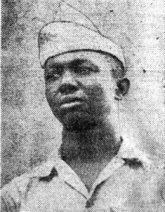
|
Voluminous is the word for Rastus' output of assorted verse, produced during his 21 months in the India-Burma Theater. An estimated 200 poems have been eagerly forwarded to the fishwrapper for inclusion in the "Poet's Corner." But no soap; Rastus is sincere, but no Tennyson - or even a Smith Dawless, whose famed Conversation Piece set a high standard for future Roundup verse.
When we wrote Rastus for his picture to run with his poem, he informed us, "This is just as great as if I was about to become a father." So for eagerness, dogged endurance, and fine spirit, the Roundup congratulates Pvt. Rastus Corley of South Carolina and Myitkyina, and presents herewith The American Red Cross.
|
CHINESE FAN-I-KUAN MOUTHPIECES
FOR AMERICAN LIAISON OFFICERS
GEN. SULTAN'S HQ., BURMA - The Chinese fan-i-kuan (pronounced fahnnygwan) is the Figaro of the Allied war effort in India-Burma.
He is the catalytic agent between American and Chinese troops a general factotum whose varied activities make him the 20th Century version of the legendary Barber of Seville, who was everywhere at once, bringing people together, smoothing out difficulties, dispelling doubts and uncertainties by the quick workings of his facile mind. Allied officers shudder to think how difficult it would be to function effectively without the fan-i-kuan.
CALLED GODSEND
The Foreign Affairs Bureau of China's National Military Council, which supervises the work of 340 fan-i-kuans assigned to combat and liaison units of the India-Burma Theater, calls him an interpreting officer. American troops attached to Chinese units, or doing liaison work, call them a godsend.
Just as essential in administrative work as they are in combat, many fan-i-kuans have spent months at the front with combat troops. Civilians in uniform, they have been fair game for Jap snipers and artillery, and quite a few are alive today only because they have learned to handle a Thompson sub-machine gun, a carbine, or an M-1.
WITH P.S. HOSPITALS
Fan-i-kuans can be found with Chinese Infantry, with the Mars Task Force, with American-Chinese tank units. They are a vital cog in their operation of American portable surgical hospitals attached to Chinese combat troops. They are indispensable at rear echelon ordnance automotive maintenance depots where Chinese soldiers are being taught American know-how in operation and maintenance of jeeps, trucks, and command cars. Without them, American-commanded, Chinese-manned artillery couldn't function.
Wherever Chinese and Americans work together, in combat, liaison, administration, or supply, there is a fan-i-kuan on hand ironing out difficulties, smoothing a path to better understanding and closer co-operation between soldiers of two nations whose mother tongues are as far apart as the two poles.
INTERPRETERS PLUS
Those who know them say they are far more than interpreters. They are suave diplomats when the occasion demands. They give advice and counsel to American officers on matters of protocol and policy. They are masters in the art of "face," so important to the Oriental mind. They ride in the lead tank of Chinese-manned, American-commanded tank units, translating commands, giving technical advice on operation and maintenance of the lumbering giants which are helping force the Jap out of Burma.
Fan-i-kuans serve as mouthpieces for American liaison officers scattered from Ledo to Chungking. Their bi-lingual knowledge is just one of the many qualifications an interpreting officer must have to do his job properly.
ALL WALKS OF LIFE
They come from all walks of life and varied backgrounds. Some have attended American universities and are as familiar with American patterns of speech and custom as they are with Chinese language and tradition. Others have been specially trained for their work under the supervision of the National Military Council in Chungking.
Graded in five classifications according to length of service, ability and qualifications, they hold equivalent rank as high as lieutenant colonel. More than 75% of those now at work in this theater hold equivalent rank of captain.
LOST WITHOUT THEM
What makes a good fan-i-kuan? Opinions among American offers differ according to the type of work they are called upon to do. All agree on certain basic qualifications.
"Without good fan-i-kuans to interpret our meaning to Chinese soldiers, we would be lost," says Lt. Col. Wellus A. Rhodes, of Meadville, Pa., attached to a tank unit. "They live with us and learn to interpret our thoughts with complete fidelity. Most of them know the importance of their mission, understand the importance of good feeling, unanimity and co-operation among Chinese and Americans. Each one feels it is part of his job to increase this spirit of co-operation. Most of them will do anything to make things better."
HAVE TO BE GOOD
"We would be groping in the fog without them," says Lt. Col. McPherson LeMoyne of Woodsville, O., attached to the same unit.
"Then men who work with us in the armored force have to be good. We work fast. All transmission of information to the tank units passes through them. They have to be quick thinkers and intelligent interpreters. Many of them have had to develop a mechanical engineering background in order to do their jobs properly. I find that it's important for them to interpret your thought as well as your meaning. The ideal fan-i-kuan can interpret, advice and can even think American."
LEND UNDERSTANDING
Maj. W. Loar Gerguson, a liaison officer with a Chinese tank group, believes that whenever there has been a mishap or a slip-up in an operation it has been due to the absence of a fan-i-kuan who could make things clear to officers and men.
"I have found that our Chinese tank men do whatever we ask of them to the best of their ability. Whenever there is a mishap, it is due to a misunderstanding," says Maj. Ferguson. "As soon as a fan-i-kuan has the picture clear in his own mind, he is able to transmit it properly."
COMBAT CARGO DROPS AID FESTING'S TROOPS
HQ., 10TH AIR FORCE, BURMA - A Combat Cargo supply drop mission is credited with enabling Maj. Gen. Francis W. Festing's British 36th Division to annihilate an entire Japanese battalion in North Burma recently.
The attacking British units were attempting to cross the Shwelhi River at Myitson, and to carry out this operation a successful supply drop of food and ammunition had to be made during the fighting.
Eight C-47's took off from an Assam base early in the morning of the operation, and seven of them landed at a forward strip in the Myitson area. The eighth plane continued to the proposed airdropping area to choose the pin-point drop target. The spot picked by the reconnaissance plane was on the south bank of the river in a clearing surrounded on three sides by Jap-infested jungle.
After being briefed by the lead crew, the pilots took the heavily laden planes carrying composite loads of food and ammunition, and the target was reached by mid-morning in the midst of heavy ground fighting.
Roaring in at 200 feet, the crews began to drop the cargo. On each pass the unarmed transports drew ground fire, but they continued to make the runs on the dropping zone until all the supplies had been dropped. The C-47's were hit repeatedly, and two kickers were wounded. Notwithstanding the difficulties, 45,000 pounds were dropped.
As a result of the mission, Myitson was captured.
In a commendation to the Combat Cargo unit, Maj. Gen. Howard C. Davidson, commanding general of the 10th Air Force said he was "most grateful for the extremely successful air drops. Their success enabled the brigade to inflict serious defeat on the Japs and almost completely destroy a Japanese battalion."
|
Dear Roundup: Here is an excerpt from a Danton Walker column in the New York Daily News, expedited to me by an unknowing reader.
"Read this and weep: In the PX's in India, the counters display amid the razor blades and gum, star sapphires retailing at 35 cents each. You can't buy them from here." - From the Mar. 13 issue, N.Y.News.
Being the simplest of man and unversed in star sapphires of their procurement, I'm taking the liberty of referring this article to you in quest of orientation. After dwelling in many parts of this theater for 15 months, I am already resigned to the opinion that what remains unseen here, is but the prototype or same, of what one has seen. It is perhaps possible that some unknown PX is yet cached away in some remote hill, wherein the profusion of star sapphires adorn the sundry shelves with grand mosaic patterns.
I beg you to relieve me and my colleagues who cannot stand the suspense nor rest the mind, until you have righted our gnawing apprehensions. By the beard of Zeus! - have mercy on our souls. - T/5 Wm. D. Keller, APO 882 (Karachi).
(S/Sgt. M. P. Hogarty, APO 220, forwarded the same clipping to Roundup. Hogarty said, "We G.I.'s out here have enough trouble without being needled by our women about stuff like that." For readers Keller and Hogarty and thousands of other I-Bers Roundup slips the needle back to Danton Walker in the place where it will do the most good. - The Editor.)
WELL, SERGEANT?
Dear Roundup: After reading M/Sgt. Marvin Swallow's bitch (Roundup-Mar. 22), about Quartermaster truck companies, might I beg to pass on a few corrections?
If my memory serves me correctly, there was no two lane highway at Ledo of the type Swallow talks about. As for C rations, we were lucky if we could carry enough to keep us from starving on the way out.
Tell me sergeant, have you ever hiked with a full field pack over the Naga Hills? Have you ever been hungry enough to scrape spoiled and partly spoiled rice off the ground and cook it in your helmet? Have you ever walked with the vision of clear cool water before you for hours at a time and were afraid to take the last drink out of your canteen? Have you ever walked advance guard, or worse yet, rear guard through enemy territory? Have you waded up to your hips carrying your guns and ammunition and pack over your head?
Have you, Sgt. Swallow, stood by the elbow of one of the best surgeons in this part of the world and by kerosene lamp and flashlight seen him take over two feet of a man's guts out and sew him up; and then three days later see that same man carried out, still alive and improving? Have you seen your own men stand in the doorway of a cargo plane that was flying so low that the trees would bend as it flew skimming the tops so as to keep out of sight of Jap planes and ground fire?
I don't mean to seem stuffy, but I have been informed from a good source that many of the boys from the QM truck companies (Mobile) have seen such things.
The "Yankee Ingenuity" you decry sergeant, was used by these men. - Cpl. W. McKinley, APO 218 (Burma).
Tiger Gives Up As G.I. Spends Night In Tree
HQ., TENTH AIR FORCE, BURMA - In the wilds of the Western U.S., cougar hunters "tree" the big cats, but here in Burma the procedure may be reversed, as T/5 Robert Pena, who recently spent the night "out on a limb" above a big Bengal tiger, will readily testify.
Pena, member of a Signal Air Warning battalion of the 10th Air Force, Eastern Air Command, is stationed at a hill post deep in the Burma jungles. He had gone down to a nearby stream to fill his water can one afternoon neglecting to take a firearm, as the stream was only a mile distant.
IN G.I. STEW
bending over the water, Pena thought he heard a louder splash than he was making. He was right. He looked up to find a situation normally the answer to a G.I. hunter's prayer: a nice, big tiger. But Pena had no gun, and he was eyeing our boy as if he were toying with the idea of sampling the G.I. stew which Pena was in.
The kitty approached closer, and Pena, seeing that he was outranked by several stripes, withdrew. Groping nervously behind him for the nearest tree, he found on, and sprang up into it with an agility to turn Tarzan green with envy. The tiger jumped about this time, also, and only a matter of inches saved that final endorsement on Pena's service record.
Our jungle villain, now exhausted by this cat-and-mousing, yawned, stretched and proceeded to lie down beneath the tree and spend the night sleeping as peacefully as the kitten on the "Chesapeake and Ohio" ad. And Pena, aloft in his leafy perch, sat chain-smoking all night to keep awake and wondering how he ever got so far from San Antonio.
TIGER TAKES OFF
Bright and early on a beautiful jungle morn, the tiger awoke, cocked one disdainful eye at Pena (who was now trying "nice kitty; go away kitty" pleadings) then turned and disappeared into a bamboo grove.
Soon after, Pena headed back for camp, bleary-eyed for lack of sleep, and met a searching party sent out for him. Detailing his experience, Pena allowed as how the saying, "There are no atheists in foxholes" must be straight stuff, for he had certainly "got religion" in that treetop.
|
G.I.'S 'FREEZING IT OUT'
AT CALCUTTA PLANT
CALCUTTA, INDIA - While thousands of GI's in India are literally sweating out this and that, a group in Calcutta is actually freezing it out, believe it or not. They're wearing heavy overcoats and gloves each day, and jumping up and down in an attempt to keep warm in temperatures ranging from 10 to 16 degrees below zero.
These men are working with a refrigeration unit in the Army cold storage warehouse at Calcutta, where thousands of tons of frozen beef, chicken and ice cream are stored for soldiers in Calcutta and the forward areas.
"It's pretty rugged when we have to step from 10 below inside to 100 in the shade outside, but than on the other hand it makes us feel pretty peppy when we step inside from outside," say Staff Sergeant Joe Mendal, of East Windsor, Canada, foreman of the plant. "And then," he added, "we figure we are doing a good job for the troops in keeping the supply of fresh meat moving, so we're willing to be unique in freezing it out for them."
T/5 Alan A. Beasley, of Louisville, Alabama, says it's the coldest he has ever experienced. "Some fellows have experienced below zero weather back in the States, but as for me, this is the coldest temperature I've ever worked in." He maintains that it will be hot even for him when he returns to Alabama.
Pfc. Claude A. Garlington, of Fordyce, Arkansas, another southerner working in the plant, is getting a great kick out of his job as a checker. "I've read about this below zero weather lots of times, and I often wondered how the people stand it, but to me it doesn't feel so bad after working in the hot sun of India," he states.
Under the supervision of Capt. T. C. Mingis, of Portsmouth, Va., the warehouse receives and sends out daily a great quantity of meat to the troops - beef, pork, chicken and bacon.
ASC Constructs Giant Storage Plant In Assam
ASSAM AIR DEPOT - American soldiers of the Air Service Command, with only "17 days" of experience in steel construction work showing in their Service Records, recently completed erection of one of the largest military warehouse structures in India - a joining of three massive hangars into a single supply warehouse that will streamline the flow of war sinews by air to China and Burma bases. The building could house a football playing field and grandstand.
Col. Russell Scott, Commanding Officer of the Northern Air Service Area Command and Col. Joseph L. Whitney, his executive officer, sent out an emergency request to their units in the Assam valley for the job. "We need men," they said. "We don't care who they are or how they get here, but we want them fast." That meant mostly cooks, clerks, radiomen, among 23 classifications remote from the job at hand.
VARIED HELP
Lt. James E. Vaux, former construction superintendent from Sioux City, Iowa, was placed in charge of the project. But the men he got weren't chosen for the job; they were the ones who could best be spared by their commanding officers.
The construction work was done entirely by enlisted men according to the depot commander, Col. Osmond J. Ritland. Mr. Eugene Noonan, civilian construction engineer employed by the AAF and Capt. Clifford F. Galley of the NASAC Engineers Section acted as consultants. T/Sgt. Joseph Simenas, 275 Temple St., Gardner, Mass., was foreman; the hundred-odd men on the job took their orders from him.
SOME EXAMPLES
For an example of the transformation of jobs take Sgt. Lemuel Cowan, Atlanta, Ga. Classified as a cook for over three years, he was suddenly put in an erection crew. In two weeks he turned into "one of the best 'climbers' we had," according to Simenas. Five of the men in the same crew were clerk-typists. Another, Pfc. Dana Deems was a coal miner back in Hepzibah, W. Va., and was classified by the Army as a parachute rigger. He was one of the men who put the building up, and did such a good job of it that sometimes "the lay-out crews couldn't get those bays put together fast enough to keep us busy." Pvt. Frederick H. Loomis, Houston, Texas, volunteered to do the surveying on the basis of a high school trigonometry course and spotted the base plates for the building without an error.
The G.I.'s beat their target date, despite constant difficulties. Chief of these was their lack of previous experience. Then, when they had gained "on-the-job" skill, a lot of them were pulled back to their parent organizations. To top it off, 33 men from an ASC Depot Supply squadron went home on rotation in the middle of the job.
British Shatter Japanese Army On Burma Plain
Roundup Staff Article
The outstanding development of the war in Burma the past week was the decisive defeat of the Japanese on the Central Plain by the British 14th Army.
The 15th can no longer be considered an effective fighting unit. The 27th and the 28th Jap armies also have been badly mauled.
The battle of Central Burma is virtually finished with British tank units celebrating a field day on the first suitable terrain in the campaign. The Japs are resisting in disorganized bands, with the sky swept completely clean of the enemy.
In the meantime, the security blackout was lifted on British operations in the Arakan with the announcement that an amphibious force had landed on Letpan and driven south to enter Taungup, main Nip supply base for the West Burma coastal area.
On the Northern Combat Area Command front under Lt. Gen. Dan I. Sultan only patrol activity was reported.
STILL AROUND
HQ., 10TH AIR FORCE, BURMA - Mechanics of the Liaison Squadron were viewing a newsreel featuring the activities of the "flying Jeeps" here recently, when suddenly the commentator blandly remarked that "pilots do all the mechanical work on these tiny aircraft, mechanics not being required."
"Shucks," commented M/Sgt. Roy F. Kapel, engineering chief, "I reckon us boys can go home. Sounds like we're surplus."
At last report the mechanics were still here.
|
No Longer Holds True
By S/SGT. KARL PETERSON Roundup Staff Writer
It is time that one of the Theater's most ancient traditions was laid away to decent rest - the fable of the Delhi Commando. Back in the early days of what was then CBI, India's sun-baked imperial capital was the fountainhead of all things good or bad that came to the lads scattered from Karachi to Kweilin. All the Theater's administrative headquarters were here, dispensing alike bounty and bafflement, until "Per Diem Hill" or "Little Washington" came to be cursed throughout the land as a nest of high living and low thinking.
Much of this, however, was a reflection of the general stagnancy here at "the end of the line," when the urgency of campaigns elsewhere and our inadequate trickle of supplies and weapons made it impossible to mount such efforts as are now winning back Burma. And so was coined the ideal of the Delhi Commando, a scapegoat for the edgy tempers of the idle boys in the weeds.
GOOD OLD DAYS
There was good reason, too. Few G.I.'s yet unrotated recall those sybaritic days in Delhi when the 10th Air Force had more air conditioning units than airplanes, more bearers than pilots, and more per diem than somewhat. Troops lounged in the luxury of the Marina Hotel and attended lush whing-dings thrown by the Maharaja of Bikaner or swimming parties at the Viceroy's. A Roundup social note of the period tells of two suave Servicemen at a garden party knocking themselves out with tea, badminton, bridge and darts - whoops! And the M.P.'s apprehended a character strolling down Queensway in a tailored khaki zoot suit, complete with peg trousers, neat pleats and a bush coat that hung to his knees.
Today it is a different horse of another color. Calcutta with its various headquarters is an important "command town," while the bright lights and night life, the men on leave there, have made it the India-Burma "Paris behind the lines."
The boys in the bush can now scream of Calcutta red tape and paper snowstorms as well. But mostly, continuing efforts to make the lot of the man in the field easier, with PX supplies, movies, Stateside USO shows, Army newspapers and better chow, have softened the contrast between urban and rural India-Burma.
CHANGES MADE
In Delhi itself, there is change. Per Diem has been cut, the boys hole up in barracks now, and the era of gabardines, shiny boots and 100-mission crush hats has gone glimmering. Delhi's uniform regulations are the most rigid in the Theater. And one big outfit is putting in these hot days indulging in basic training, but physically.
Delhi doesn't have the humidity found at some stations in I-B, but plenty of summertime heat. If the temperature ever dropped below 100 degrees in May they'd probably issue overcoats, and you can fry coconuts on the sidewalk in Connaught Circus. Some of the Theater's finest prickly heat cases flourish here, and latrine trotting by G.I.'s with the "G.I.s" is a highly developed art. Malum "Delhi belly?" There are plenty of thorns in the Delhi bed of roses.
One relic of the Amreekan pukka sahib era still remains. Cynics claim that a direct bomb hit on the India Coffee House at 10 o'clock in the morning would kill half the troops in Delhi. But somebody must be working; who do you think turns out all that paper, buddy?
For the final verdict on Delhi, ask the Burma infantrymen, boys who were wounded or exhausted by combat now transferred to guard duty in the city of circular streets. Are they happy here? Keep shoes shined, stay strictly in uniform, clothes clean and neat, salute, fall in, fall out, inspection, "out of bounds," "Prohibited," "will cease immediately." No, sir, don't fence me in, doc. Give me back my basha by the Brahmaputra's bank, a loaf of Spam, a jug of Bull Fight and my old dirty fatigues. We got the Delhi Deadly Dolors, and it ain't good.
The Roundup is a weekly newspaper of the United States Forces, published by and for the men in Burma and India, from news and pictures supplied by staff members, soldier correspondents, United Press, OWI, and Army News Service. The Roundup is published Thursday of each week and is printed by The Statesman in New Delhi and Calcutta, India. Editorial matter should be sent directly to Capt. Floyd Walter, Hq., U.S.F., I.B.T., New Delhi, India, and should arrive not later than Sunday in order to be included in that week's issue. Pictures must arrive by Saturday and must be negatives or enlargements. Stories should contain full name and organization of sender. Complaints about circulation should be sent directly to Lt. S.R. Rose, Hq., U.S.F., I.B.T., New Delhi, India. Units on the mailing list should make notification of any major change in personnel strength or any change of APO.

|
APRIL 12, 1945
Original issue of India-Burma Theater Roundup shared by CBI Veteran Dave Dale
Copyright © 2008 Carl Warren Weidenburner
TOP OF PAGE PRINT THIS PAGE ABOUT THIS PAGE SEND COMMENTS
PREVIOUS ISSUE CLOSE THIS WINDOW NEXT ISSUE
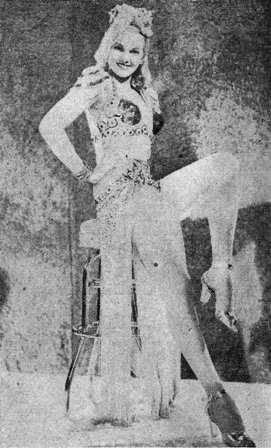 Meet Adele Jergens, Columbia Pictures' newest glamour recruit. Miss Jergens came to the movies via modeling, ballet,
and the theater. Some of the boys down Kandy way did us this favor.
Meet Adele Jergens, Columbia Pictures' newest glamour recruit. Miss Jergens came to the movies via modeling, ballet,
and the theater. Some of the boys down Kandy way did us this favor.
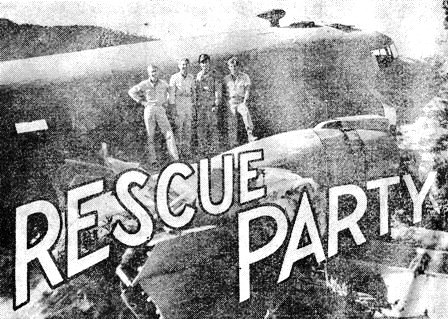 Four pioneers of the Rescue Squadron of Air Transport Command pose for a picture during a search mission in China.
At right is their leader, intrepid Capt. John L. Porter, later killed in a B-25 search plane after being attacked by
Jap fighters.
Four pioneers of the Rescue Squadron of Air Transport Command pose for a picture during a search mission in China.
At right is their leader, intrepid Capt. John L. Porter, later killed in a B-25 search plane after being attacked by
Jap fighters.
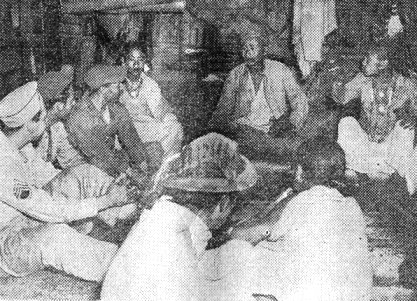 Downed fliers get a hearty welcome, needed help and quarters for the night from Burma hill
tribesmen, while awaiting
aid from the ATC Search & Rescue Squadron. People of the Hump area have proven friendly, cooperative and a valuable
asset.
Downed fliers get a hearty welcome, needed help and quarters for the night from Burma hill
tribesmen, while awaiting
aid from the ATC Search & Rescue Squadron. People of the Hump area have proven friendly, cooperative and a valuable
asset.
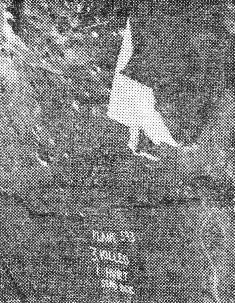 Panels dropped from a rescue plane spell out the story of the tragedy for three crew members and request medical
attention for a fourth. "PLANE 593 - 3 KILLED - 1 HURT - SEND DOC"
Panels dropped from a rescue plane spell out the story of the tragedy for three crew members and request medical
attention for a fourth. "PLANE 593 - 3 KILLED - 1 HURT - SEND DOC"

 Excavation of a dud 500-pounder less than a quarter of a mile from the headquarters of the Tenth Air Force in
Burma is underway with a Burmese handling the shovel. The lower hole is where the dud entered and the digging proceeds from
a point directly above where the bomb is believed to have stopped.
Excavation of a dud 500-pounder less than a quarter of a mile from the headquarters of the Tenth Air Force in
Burma is underway with a Burmese handling the shovel. The lower hole is where the dud entered and the digging proceeds from
a point directly above where the bomb is believed to have stopped.

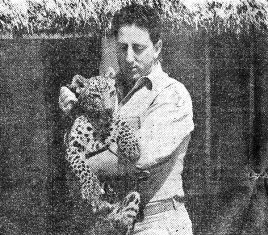 S/Sgt. Emile Manara of the XX Bomber Command holds Mary, one of his 40-pound leopards. The handsome spotted cat, along
with Susie, sleeps under the sergeant's bed each night. If you ask us, Mary seems to be mentally licking her chops.
S/Sgt. Emile Manara of the XX Bomber Command holds Mary, one of his 40-pound leopards. The handsome spotted cat, along
with Susie, sleeps under the sergeant's bed each night. If you ask us, Mary seems to be mentally licking her chops.
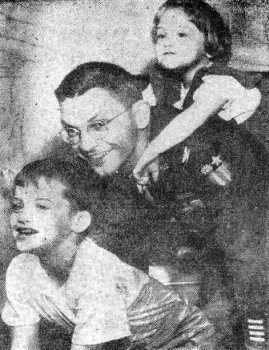 Col. Joseph Stilwell, Jr., son of Gen. Joseph W. Stilwell, romps with his children, Joe III and Kiki, after arriving
at his home in Columbus, Ga., from the India-Burma Theater.
Col. Joseph Stilwell, Jr., son of Gen. Joseph W. Stilwell, romps with his children, Joe III and Kiki, after arriving
at his home in Columbus, Ga., from the India-Burma Theater.

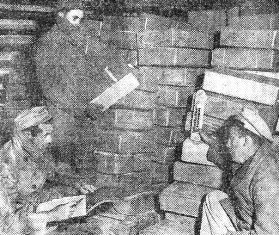 These Americans have found a cool spot in India. But they had to go in a cold storage plant to get away from the
heat waves. The scene is Calcutta, India, and T/Sgt. Joe Mendal, left, checks the thermometer with Capt. T. C. Mingis,
while T/5 Alan A. Beasley brings in a steak. The plant houses meats and ice cream.
These Americans have found a cool spot in India. But they had to go in a cold storage plant to get away from the
heat waves. The scene is Calcutta, India, and T/Sgt. Joe Mendal, left, checks the thermometer with Capt. T. C. Mingis,
while T/5 Alan A. Beasley brings in a steak. The plant houses meats and ice cream.
